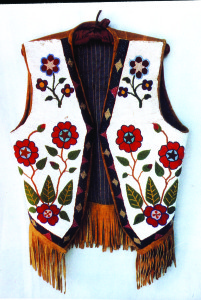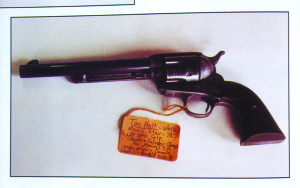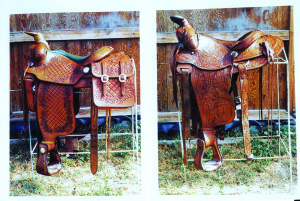Age, workmanship and provenance (ownership history) give added value to American cowboy collectibles. If it’s old, beautifully crafted by hand of the best materials, or can be traced as owned and used by famous cowboys, the price escalates.
When all cowboys still rode horses to get around on their jobs, the saddle was their most prized possession, often custom-made to their own specifications and sometimes costing up to a year of their salary. Their boss at the ranch would supply a horse for them to ride, but rarely a saddle.
“When down on his luck, a cowhand would pawn his watch (if he had one) or even his pistol, but never his saddle,” said William C. Ketchum, Jr. in “Western Memorabilia: Collectibles of the Old West” (1980).
Vintage old cowboy saddles start at a few hundred dollars for plain, worn out examples, and reach many thousands of dollars for the best specimens once owned by movie star cowboys or traced to Confederate origins in the Civil War.
To preserve and protect old leather saddles, keep them in a dry place with moth ball protection if they have a sheepskin lining, but never use water, vegetable oil or motor oil on them, “no matter what anyone tells you,” advised Joice Overton in “Cowboy Equipment,” an inspiring hand book for beginning collectors of old cowboy artifacts, published in 1998 for $39.95 and well worth finding at your book store or library.
Overton also recommended to protect old saddles by wiping them down with a good liquid glycerin saddle soap, applied with a piece of sheepskin, and, “as a final step, rub it down well with Neatsfoot Oil on a soft cloth.”
Nice old saddle bags can go for hundreds of dollars a pair and up in today’s market. Look for U.S. Cavalry saddle bags that were popular with cowboys because of their large size, soft leather, sturdy double or triple buckle closures and canvas liners that could be removed and cleaned.
Look for hand carved saddle bags with fancy designs. Look for elk hide or bear skin saddle bags, well preserved.
Cowboy horse bridles and reins, separate bits and spurs are specialized fields of collectibles, admired greatly if they are very old and Mexican style with silver trim, hand-tooled to perfection. Overton wrote a whole book of “Cowboy Bits & Spurs.” with over 400 color photos, so it is easy to see the wide variety and price range of these interesting objects.
If you’ve never paid attention to horse bits before, you might not recognize them in antique shops or elsewhere offered for sale. Overton mentions an old Mission style “spade” bit in original condition “except for added patina,” now worth $3,000 to $4,000, but unmarked, “as no marks were ever used by the early Missions.”
 Many rare spurs are worth thousands of dollars per pair. All American cowboy spurs evolved from their Mexican Vaquero roots that came to the New World in 1520 with Cortez. Genuine 16th century Spanish Conquistador spurs are unlikely to be found for sale today, but California style spurs with their fancy silver overlays and inlays, two piece construction, large rowels and sometimes double heel chains go for thousands of dollars for the best examples.
Many rare spurs are worth thousands of dollars per pair. All American cowboy spurs evolved from their Mexican Vaquero roots that came to the New World in 1520 with Cortez. Genuine 16th century Spanish Conquistador spurs are unlikely to be found for sale today, but California style spurs with their fancy silver overlays and inlays, two piece construction, large rowels and sometimes double heel chains go for thousands of dollars for the best examples.
19th century American cowboys often purchased their leather clothing from nearby Indians, especially hand-made buckskin jackets, vests and gloves. That’s why we often find such vintage cowboy clothes decorated with beadwork.
An authentic Native American Indian-made fully beaded cowboy vest is a thing to behold, worthy of display in a museum exhibit. New collectors to cowboy memorabilia may think that such an article of clothing was made for a woman to wear, not realizing that real cowboys often wore very colorfully embellished clothing, including brightly colored neckerchiefs, despite the drab “rough look” conveyed in the mythical cowboy image in fictional Old West movies.
In fact, unlike movie cowboys who also seem to double as professional gunslingers, real cowboys preferred to carry a Winchester repeating rifle instead of a pistol because the rifle was more practical in hunting game and fighting off marauding Indians and cattle rustlers.
 These old Winchesters start at about $500 and rapidly rise in price for better condition and custom engravings. The short barrel Winchester carbines were especially sought by cowboys who fit them snugly in a scabbard attached to their saddles. Original scabbards add value to the weapon.
These old Winchesters start at about $500 and rapidly rise in price for better condition and custom engravings. The short barrel Winchester carbines were especially sought by cowboys who fit them snugly in a scabbard attached to their saddles. Original scabbards add value to the weapon.
When cowboys did carry pistols, they were hopefully of large caliber such as the legendary Colt .45 single action six-shot revolver, known as the “Frontier Model” and later as the “Peacemaker.” Nice old Peacemakers go for a couple of thousand dollars or more, but there are beat-up rusted examples worth little without fantastic provenance, such as once owned by a famous gunman.
Overton lists a Colt .38 caliber revolver that was once owned by Tim Holt, the movie cowboy, with his name tag still attached to trace provenance, and valued at $2,000 to $2,500 in 1998. Watch out for weapons with faked stories behind them.
Those fancy silver belt buckles are mostly a 20th century creation for rodeo awards and movie cowboys, but they are still beautiful and quite collectible, although often overpriced for the tacky specimens that we see too commonly today in junk shops and swap meets.
Original early 20th century sterling silver rodeo buckles are what we want, or hand-crafted one-of-a-kind Indian silver buckles made for the long ago tourist trade at Fred Harvey shops, or prison-made buckles with cowboy themes and originating in old Western state prisons, but be careful they aren’t recent replicas, mass-produced to feed the insatiable demand for decorative cowboy gear.
Overton mentions several early 20th century trophy buckles done in gold and silver, priced at $150 to $300 each, and says they were often donated to events by local merchants, and “are very collectible, but beware of many fakes.”
About the above images:
Two outstanding saddles in the Overton Collection. At left is an example with matching saddle bags, sterling silver trim and full leather covered stirrups, made by the late Charlie Baker of Baker, Oregon, valued at $5,000 to $6,000. At right is another nicely carved and worked saddle, built in the prison at McCallister, Oklahoma, valued at $1,200 to $1,700. Both illustrated in “Cowboy Equipment” by Joice Overton.
A cowboy vest made by the Ogallala Sioux, fully beaded, the result of many hours of work, valued at $3,500 to $5,000. Courtesy of Paul and Marlene Snider, as illustrated in “Cowboy Equipment” by Joice Overton.
A Colt .38 caliber revolver, once owned by Tim Holt, the cowboy movie star, with the initials “T.H.” under the grips. Its barrel and cylinder were changed for the movies, and modified to shoot one to five blanks. Valued at $2,000 to $2,500, courtesy of Paul and Marlene Snider, as shown in “Cowboy Equipment” by Joice Overton.
















Follow Us